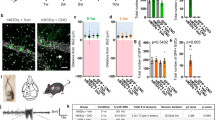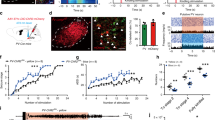Abstract
Epilepsy is a common and refractory neurological disorder, but the neuronal regulatory mechanisms of epileptogenesis remain largely unclear. Activity-dependent transcription of genes for neurotrophins such as brain-derived neurotrophic factor (BDNF) has been shown to promote epileptogenesis; however, little is known about factors that may act as intrinsic, homeostatic or counterbalancing mechanisms. Using rodent models, here we show that limbic seizure activity upregulated NRG1–ErbB4 signaling and that epileptogenesis was inhibited by infusing NRG1 intracerebrally but exacerbated by neutralizing endogenous NRG1 with soluble ErbB4 extracellular domain, by inhibiting ErbB4 activation or by deleting the Erbb4 gene. Furthermore, specific depletion of ErbB4 in parvalbumin-expressing interneurons abolished NRG1-mediated inhibition of epileptogenesis and promoted kindling progression, resulting in increased spontaneous seizures and exuberant mossy fiber sprouting. In contrast, depleting ErbB4 in CaMKIIα-positive pyramidal neurons had no effect. Thus, NRG1-induced activation of ErbB4 in parvalbumin-expressing inhibitory interneurons may serve as a critical endogenous negative-feedback mechanism to suppress limbic epileptogenesis.
This is a preview of subscription content, access via your institution
Access options
Subscribe to this journal
Receive 12 print issues and online access
$209.00 per year
only $17.42 per issue
Buy this article
- Purchase on Springer Link
- Instant access to full article PDF
Prices may be subject to local taxes which are calculated during checkout








Similar content being viewed by others
References
Morimoto, K., Fahnestock, M. & Racine, R.J. Kindling and status epilepticus models of epilepsy: rewiring the brain. Prog. Neurobiol. 73, 1–60 (2004).
Hauser, W.A., Annegers, J.F. & Kurland, L.T. Incidence of epilepsy and unprovoked seizures in Rochester, Minnesota: 1935–1984. Epilepsia 34, 453–468 (1993).
McNamara, J.O., Huang, Y.Z. & Leonard, A.S. Molecular signaling mechanisms underlying epileptogenesis. Sci. STKE 2006, re12 (2006).
Duncan, J.S., Sander, J.W., Sisodiya, S.M. & Walker, M.C. Adult epilepsy. Lancet 367, 1087–1100 (2006).
Rice, A.C. & DeLorenzo, R.J. Kindling induces long-term changes in gene expression. in. Kindling 5 (eds. Corcoran, M. & Moshe, S.) 267–284 (Plenum, 1998).
Delorenzo, R.J. & Morris, T.A. Long-term modulation of gene expression in epilepsy. Neuroscientist 5, 86–99 (1999).
Hughes, P.E. et al. Activity and injury-dependent expression of inducible transcription factors, growth factors and apoptosis-related genes within the central nervous system. Prog. Neurobiol. 57, 421–450 (1999).
Binder, D.K., Routbort, M.J., Ryan, T.E., Yancopoulos, G.D. & McNamara, J.O. Selective inhibition of kindling development by intraventricular administration of TrkB receptor body. J. Neurosci. 19, 1424–1436 (1999).
He, X.P. et al. Conditional deletion of TrkB but not BDNF prevents epileptogenesis in the kindling model. Neuron 43, 31–42 (2004).
Mei, L. & Xiong, W.C. Neuregulin 1 in neural development, synaptic plasticity and schizophrenia. Nat. Rev. Neurosci. 9, 437–452 (2008).
Steiner, H., Blum, M., Kitai, S.T. & Fedi, P. Differential expression of ErbB3 and ErbB4 neuregulin receptors in dopamine neurons and forebrain areas of the adult rat. Exp. Neurol. 159, 494–503 (1999).
Chen, M.S. et al. Expression of multiple neuregulin transcripts in postnatal rat brains. J. Comp. Neurol. 349, 389–400 (1994).
Eilam, R., Pinkas-Kramarski, R., Ratzkin, B.J., Segal, M. & Yarden, Y. Activity-dependent regulation of Neu differentiation factor neuregulin expression in rat brain. Proc. Natl. Acad. Sci. USA 95, 1888–1893 (1998).
Woo, R.S. et al. Neuregulin-1 enhances depolarization-induced GABA release. Neuron 54, 599–610 (2007).
Wen, L. et al. Neuregulin 1 regulates pyramidal neuron activity via ErbB4 in parvalbumin-positive interneurons. Proc. Natl. Acad. Sci. USA 107, 1211–1216 (2010).
Neddens, J. & Buonanno, A. Selective populations of hippocampal interneurons express ErbB4 and their number and distribution is altered in ErbB4 knockout mice. Hippocampus 20, 724–744 (2010).
Fazzari, P. et al. Control of cortical GABA circuitry development by Nrg1 and ErbB4 signalling. Nature 464, 1376–1380 (2010).
Fisahn, A., Neddens, J., Yan, L.Q. & Buonanno, A. Neuregulin-1 modulates hippocampal gamma oscillations: implications for schizophrenia. Cereb. Cortex 19, 612–618 (2009).
Vullhorst, D. et al. Selective expression of ErbB4 in interneurons, but not pyramidal cells, of the rodent hippocampus. J. Neurosci. 29, 12255–12264 (2009).
McBain, C.J. & Fisahn, A. Interneurons unbound. Nat. Rev. Neurosci. 2, 11–23 (2001).
Markram, H. et al. Interneurons of the neocortical inhibitory system. Nat. Rev. Neurosci. 5, 793–807 (2004).
Pitcher, G.M. et al. Schizophrenia susceptibility pathway neuregulin 1-ErbB4 suppresses Src upregulation of NMDA receptors. Nat Med.
Ting, A.K. et al. Neuregulin 1 promotes excitatory synapse development and function in GABAergic interneurons. J. Neurosci. 31, 15–25 (2011).
Chen, Y.J. et al. ErbB4 in parvalbumin-positive interneurons is critical for neuregulin 1 regulation of long-term potentiation. Proc. Natl. Acad. Sci. USA.
Iyengar, S.S. & Mott, D.D. Neuregulin blocks synaptic strengthening after epileptiform activity in the rat hippocampus. Brain Res. 1208, 67–73 (2008).
Ozaki, M., Itoh, K., Miyakawa, Y., Kishida, H. & Hashikawa, T. Protein processing and releases of neuregulin-1 are regulated in an activity-dependent manner. J. Neurochem. 91, 176–188 (2004).
Backx, L., Ceulemans, B., Vermeesch, J.R., Devriendt, K. & Van Esch, H. Early myoclonic encephalopathy caused by a disruption of the neuregulin-1 receptor ErbB4. Eur. J. Hum. Genet. 17, 378–382 (2009).
Goddard, G.V., McIntyre, D.C. & Leech, C.K. A permanent change in brain function resulting from daily electrical stimulation. Exp. Neurol. 25, 295–330 (1969).
Racine, R.J. Modification of seizure activity by electrical stimulation. II. Motor seizure. Electroencephalogr. Clin. Neurophysiol. 32, 281–294 (1972).
Curia, G., Longo, D., Biagini, G., Jones, R.S. & Avoli, M. The pilocarpine model of temporal lobe epilepsy. J. Neurosci. Methods 172, 143–157 (2008).
Roysommuti, S., Carroll, S.L. & Wyss, J.M. Neuregulin-1beta modulates in vivo entorhinal-hippocampal synaptic transmission in adult rats. Neuroscience 121, 779–785 (2003).
Tidcombe, H. et al. Neural and mammary gland defects in ErbB4 knockout mice genetically rescued from embryonic lethality. Proc. Natl. Acad. Sci. USA 100, 8281–8286 (2003).
Bjarnadottir, M. et al. Neuregulin1 (NRG1) signaling through Fyn modulates NMDA receptor phosphorylation: differential synaptic function in NRG1+/− knock-outs compared with wild-type mice. J. Neurosci. 27, 4519–4529 (2007).
Gu, Z., Jiang, Q., Fu, A.K., Ip, N.Y. & Yan, Z. Regulation of NMDA receptors by neuregulin signaling in prefrontal cortex. J. Neurosci. 25, 4974–4984 (2005).
Li, B., Woo, R.S., Mei, L. & Malinow, R. The neuregulin-1 receptor ErbB4 controls glutamatergic synapse maturation and plasticity. Neuron 54, 583–597 (2007).
Chen, Q. et al. Differential roles of NR2A- and NR2B-containing NMDA receptors in activity-dependent brain-derived neurotrophic factor gene regulation and limbic epileptogenesis. J. Neurosci. 27, 542–552 (2007).
Bertram, E.H. & Cornett, J. The ontogeny of seizures in a rat model of limbic epilepsy: evidence for a kindling process in the development of chronic spontaneous seizures. Brain Res. 625, 295–300 (1993).
Stoll, S.W. et al. Differential utilization and localization of ErbB receptor tyrosine kinases in skin compared to normal and malignant keratinocytes. Neoplasia 3, 339–350 (2001).
Stevens, J.R. Epilepsy, psychosis and schizophrenia. Schizophr. Res. 1, 79–89 (1988).
Kido, H. & Yamaguchi, N. Clinical studies of schizophrenia-like state in epileptic patients. Jpn. J. Psychiatry Neurol. 43, 433–438 (1989).
Bruton, C.J., Stevens, J.R. & Frith, C.D. Epilepsy, psychosis, and schizophrenia: clinical and neuropathologic correlations. Neurology 44, 34–42 (1994).
Sachdev, P. Schizophrenia-like psychosis and epilepsy: the status of the association. Am. J. Psychiatry 155, 325–336 (1998).
Qin, P., Xu, H., Laursen, T.M., Vestergaard, M. & Mortensen, P.B. Risk for schizophrenia and schizophrenia-like psychosis among patients with epilepsy: population based cohort study. Br. Med. J. 331, 23 (2005).
Bob, P., Palus, M., Susta, M. & Glaslova, K. Sensitization, epileptic-like symptoms and local synchronization in patients with paranoid schizophrenia. Prog. Neuropsychopharmacol. Biol. Psychiatry 34, 143–146 (2010).
Cascella, N.G., Schretlen, D.J. & Sawa, A. Schizophrenia and epilepsy: is there a shared susceptibility? Neurosci. Res. 63, 227–235 (2009).
García-Rivello, H. et al. Dilated cardiomyopathy in Erb-b4-deficient ventricular muscle. Am. J. Physiol. Heart Circ. Physiol. 289, H1153–H1160 (2005).
Hippenmeyer, S. et al. A developmental switch in the response of DRG neurons to ETS transcription factor signaling. PLoS Biol. 3, e159 (2005).
Casanova, E. et al. A CamKII alpha iCre BAC allows brain-specific gene inactivation. Genesis 31, 37–42 (2001).
Casanova, E. et al. ER-based double iCre fusion protein allows partial recombination in forebrain. Genesis 34, 208–214 (2002).
Acknowledgements
We thank M. Gassmann (University of Basel) for kindly supplying us with heart-rescued Erbb4−/− mice, C. Lai (Indiana University) for Erbb4loxP/loxP mice, S. Arber (University of Basel) for Pvalb-cre mice and G. Schütz (German Cancer Research Center) for Camk2a-iCre and Camk2a-CreER mice. We also thank T.-M. Gao (Southern Medical University) for help concerning transgenic mice and M. Sliwkowski (Genentech) for NRG1. We are grateful to J.O. McNamara and M.-M. Poo for their comments on this work. We also thank Y.-J. Xin, X.-Y. Feng, L. Huang, B. Lu and Y. Shen for their help on genotyping, animal models and histological experiments. This work was supported in part by grants from the 973 Program (2011CBA00407), National Natural Science Foundation of China (30925016; 31021063) and Chinese Academy of Sciences (XDA01020305) to Z.Q.X. and from the US National Institutes of Health to L.M.
Author information
Authors and Affiliations
Contributions
G.-H.T., Y.-Y.L. and Z.-Q.X. designed the project; G.-H.T., Y.-Y.L., X.-L.H. and D.-M.Y. performed the research; L.M. provided laboratory sources of reagents and transgenic mice. G.-H.T., Y.-Y.L., L.M. and Z.-Q.X. interpreted the data and wrote the paper.
Corresponding authors
Ethics declarations
Competing interests
The authors declare no competing financial interests.
Supplementary information
Supplementary Text and Figures
Supplementary Figures 1–11 and Supplementary Table 1 (PDF 3009 kb)
Rights and permissions
About this article
Cite this article
Tan, GH., Liu, YY., Hu, XL. et al. Neuregulin 1 represses limbic epileptogenesis through ErbB4 in parvalbumin-expressing interneurons. Nat Neurosci 15, 258–266 (2012). https://doi.org/10.1038/nn.3005
Received:
Accepted:
Published:
Issue Date:
DOI: https://doi.org/10.1038/nn.3005
This article is cited by
-
Impairments of GABAergic transmission in hippocampus mediate increased susceptibility of epilepsy in the early stage of Alzheimer’s disease
Cell Communication and Signaling (2024)
-
Genetic labeling reveals spatial and cellular expression pattern of neuregulin 1 in mouse brain
Cell & Bioscience (2023)
-
Prenatal dexamethasone exposure induces anxiety- and depressive-like behavior of male offspring rats through intrauterine programming of the activation of NRG1-ErbB4 signaling in hippocampal PV interneurons
Cell Biology and Toxicology (2023)
-
Transmembrane protein 108 inhibits the proliferation and myelination of oligodendrocyte lineage cells in the corpus callosum
Molecular Brain (2022)
-
Estrogen receptor β deficiency impairs gut microbiota: a possible mechanism of IBD-induced anxiety-like behavior
Microbiome (2022)



